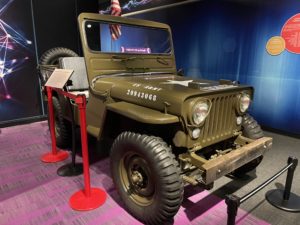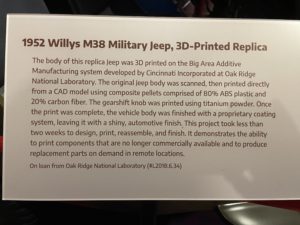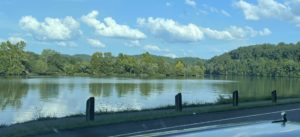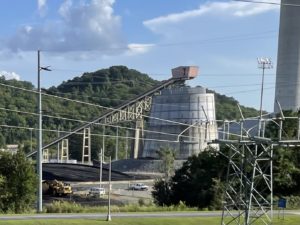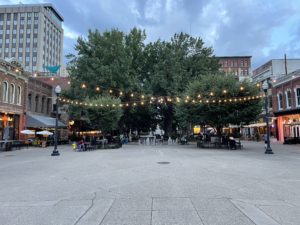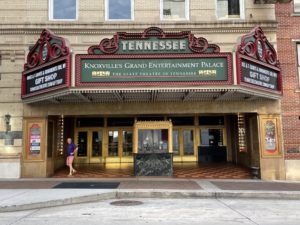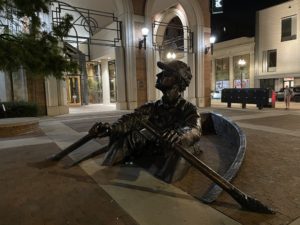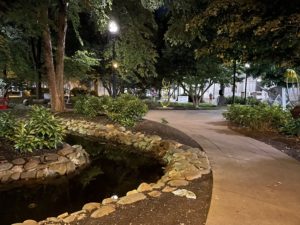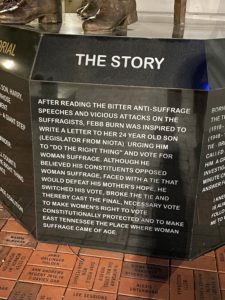In which Sid and Doris have a small mechanical and an electrifying experience.
The day starts slowly as the One More Broken Egg, our chosen breakfast venue , is queued out the door (maybe it was a bit optimistic asking TripAdvisor for Best Breakfast Venue) and we will not go back to the hotel’s Starbucks. We pass up the Wild Beaver saloon as the beave in question looks a lot too bright for breakfast time. It then takes 20 minutes for Doris to re-negotiate the parking so we can leave without getting stung for another $50. All quite dull.
, is queued out the door (maybe it was a bit optimistic asking TripAdvisor for Best Breakfast Venue) and we will not go back to the hotel’s Starbucks. We pass up the Wild Beaver saloon as the beave in question looks a lot too bright for breakfast time. It then takes 20 minutes for Doris to re-negotiate the parking so we can leave without getting stung for another $50. All quite dull.
We stop for top grade Shell after a little pinking from buying lower octane fuels. 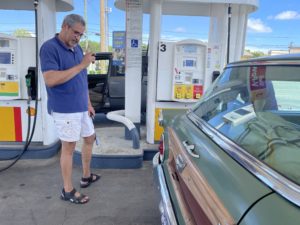 This picture shows the effect of the JGG at many stops, as our new friend tells us about his family’s Ford Wagon and the Galaxie 500 his father gave him for his high school car. More pictures are taken for him to send to his family. These little meetings are part of why Sid and Doris do Sid and Doris.
This picture shows the effect of the JGG at many stops, as our new friend tells us about his family’s Ford Wagon and the Galaxie 500 his father gave him for his high school car. More pictures are taken for him to send to his family. These little meetings are part of why Sid and Doris do Sid and Doris.
Appropriately somewhere soon after Cookeville we stop for a country store lunch. Getting back to the car we find a thin stream of bright green coolant dripping from under the radiator. Popping the bonnet we find a split in the top of the radiator, which is better than the bottom. 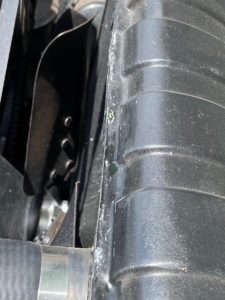
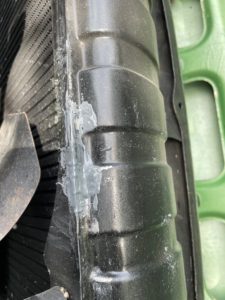 Doris marks the spot. We move the car to the shade and investigate our commodious spares and tools bag (thanks Matt!). Sid puts on the rubber gloves and very cautiously mixes up some super toxic liquid metal with its hardener and spreads at around the hole. We give it 20 minutes to begin curing and set off, knowing it really needs hours to cure. Still if heat accelerates the process it’ll soon be done. But if it will not stick to a surface wetting from the inside then cured or not water will come past. We shall see.
Doris marks the spot. We move the car to the shade and investigate our commodious spares and tools bag (thanks Matt!). Sid puts on the rubber gloves and very cautiously mixes up some super toxic liquid metal with its hardener and spreads at around the hole. We give it 20 minutes to begin curing and set off, knowing it really needs hours to cure. Still if heat accelerates the process it’ll soon be done. But if it will not stick to a surface wetting from the inside then cured or not water will come past. We shall see.
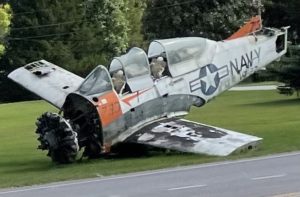 So by now we are running late for Oak Ridge and the American Museum for Science Education. And then we find that the AMSE, while still being in Tennessee, is unexpectedly the other side of the EST dateline and we lose another hour. Sid drives determinedly past an unlabelled and inexplicable Navy plane in Coalfield and even Doris doesn’t want to stop and check it out.
So by now we are running late for Oak Ridge and the American Museum for Science Education. And then we find that the AMSE, while still being in Tennessee, is unexpectedly the other side of the EST dateline and we lose another hour. Sid drives determinedly past an unlabelled and inexplicable Navy plane in Coalfield and even Doris doesn’t want to stop and check it out.
Some good news, there is an O’Reillys (Halfords equivalent but with vast amounts of parts held in stock in every branch) right by the museum and open till 8pm which is late enough whichever time zone you are in.
Saving that till later we rush in to the museum to see the history of the work at Oak Ridge to provide the Uranium and Plutonium for the atomic bombs, Little Boy and Fat Man dropped on Japan in August 1945. The receptionist says that she will let us in for free as we only have 40 minutes, and tells us we are the only people in the place. She tells us what films she can run for us.
The Manhattan Project ran from late 1942 with sites at Los Alamos in New Mexico and around Knoxville, later named Oak Ridge. The 59,000 acres requisitioned was initially known as Clinton Engineer Works, after the nearest town. The speed with which war drives development is very impressive. By 1945 Oak Ridge was a town of 75,000 people. The town and works required enormous amounts of energy and a power station was built.
The K-25 plant housed the British designed gaseous diffusion apparatus to partially enrich uranium. It was a mile long, U shaped, and the world’s largest building at the time. However, the process was not without problems and it was further developed to support a thermal diffusion works modeled on US Navy work for nuclear submarines. The navy is very used to dealing with large boilers and high steam pressure. It was Oppenheimer who was keeping up to date with the navy work who suggested the Manhattan team should have a look.
X-10 building was the pile to turn uranium slugs into plutonium, based on Fermi’s work in Chicago. That was still producing medical isotopes in 1963.
Y-12 used an electromagnetic separation method to collect U238. The Manhattan project backed both methods but even so the amounts collected from each machine were small so they just built a lot of machines. The people minding the machines were not told what they did, only what parameters the gauges should show. Most of the people at the works only knew what they had done after the bombs were dropped on Hiroshima and Nagasaki.
The works have all been removed as they were rather contaminated and had no other use.
More interestingly to Doris, they have their very own George Rhoads kinetic sculpture. Ever since she first saw “42nd Street Ballroom” in the Port Authority Bus Terminal in New York, Doris has been fascinated by his work, and to her great joy you can still buy them, now made by Creative Machines.
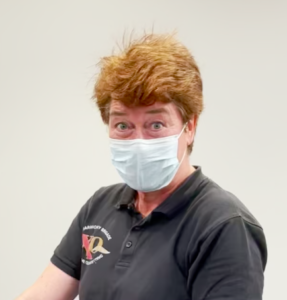 The only thing in fact that could lure her away was the opportunity to get up close with a Van der Graff generator, although progress immediately came to another halt when Sid discovered a 3D printed Jeep.
The only thing in fact that could lure her away was the opportunity to get up close with a Van der Graff generator, although progress immediately came to another halt when Sid discovered a 3D printed Jeep.
The museum is very nicely done and the people charming. If you cannot get along to Oak Ridge then do see www.atomicheritage.org for Oak Ridge TN. The effort and organisation is amazing.
And with that, over the hills and past a decidedly non-nuclear power plant into Knoxville.
The town is charming having a long market square with food, drink and one of the least talented but most persevering violin buskers we have ever heard. The main street has its old cinemas and theatres with real box offices out front and there is an engaging sculpture park.
Knoxville is also very proud of the part it played in the women’s suffrage movement. A satisfying day all round.
